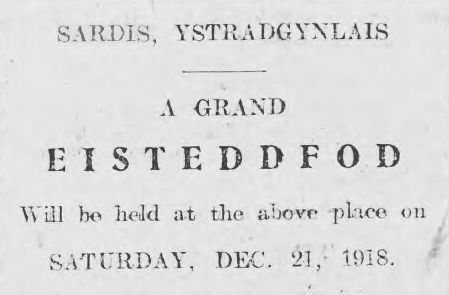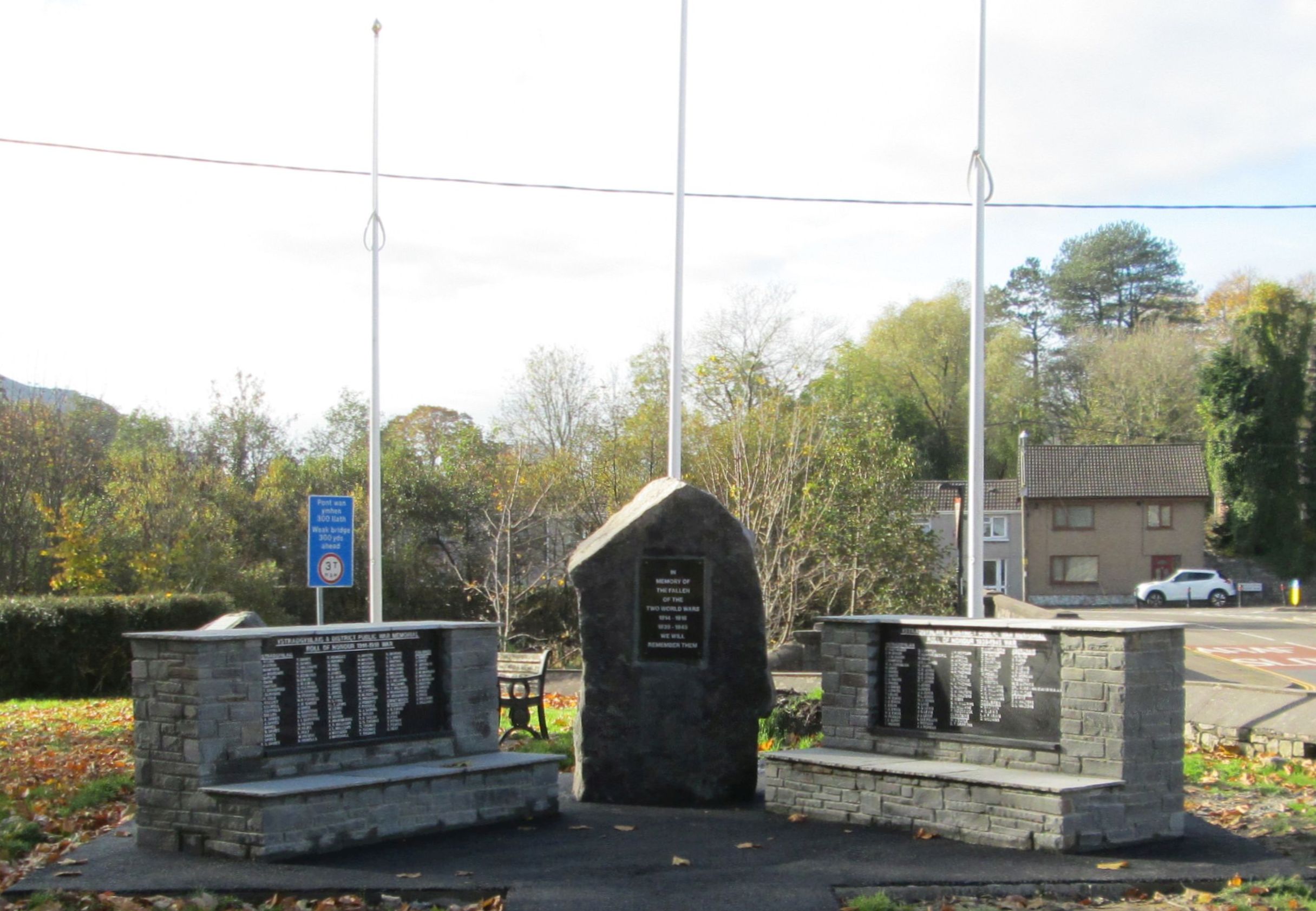Ystradgynlais & District
History and Heritage
Centenary of Sardis Chapel, 1932
Sardis Chapel in Ystradgynlais celebrated its centenary in 1932. This exceptionally long article is from the South Wales Voice Saturday December 3rd 1932. It covered a large section of the front page of the newspaper, as well as a substantial part of an inner page:-
YSTRADGYNLAIS CENTENARY SERVICES
Early Struggles of Sardis
History of the Cause
The story of the early struggles of congregationalists in Ystradgynlais to establish a cause in the place, was told at the centenary services which took place at Sardis Chapel on Monday evening. Men and women were involved in the movement to form a church and to provide a building worthy of the best traditions of the denomination and from their efforts emerged a church which is held in high esteem in Welsh religious circles.
The first chapel, built on the canal bank, had to be demolished on account of subsidence; but this was a blessing in disguise, for the new chapel, which was built in a more suitable spot, is a fine building which serves a wide community. The service was well-attended and old members related interesting reminiscences of bygone days.
It was 100 years ago that the Welsh congregationalists erected their first chapel in Ystradgynlais. The centenary is being celebrated this year and services were held at Sardis on Sunday and Monday to mark the event.
There were large congregations on Sunday, when the special preachers were the Reverend R M Rhys, Drefach, a former minister of the church and Morgan Price, Abercwmboi, a product of the church.
The Reverend D J Moses, BA, pastor, presided over a large gathering at a public meeting on Monday evening. He was suppported by the Reverends Arthur Jones, BA, Pantteg; E T Evans, BA, Wern; Melville Philips, English Congregational; W D Roderick, Rhiwfawr; R W Rhys, Drefach; Edwin Jones, Cwmllynfell; Isaac Morris, BA, BD, Tabernacle; W M Lloyd, Briton Ferry; and John Edwards, Peniel, Penrhos.
In the course of an interesting address the chairman said the church had gone through many crises in past years. We were being asked if we really addressed anyone when praying. And was religion an illusion. There was no doubt about the reality of religion or the centenary of Sardis Chapel would not be celebrated that night. The task of the church was to get people to live the best life.
The chairman referred to the absence of the Reverend W Moelfryn Morgan, Llandebi, a former pastor who was to have taken part in the celebrations but he had been taken ill.
A vote of condolence and expression of hope for his recovery was passed, all present standing up at the request of the chairman.
REMINISCENCES OF SIXTY YEARS
Mr John Edwards, Penrhos, spoke in a very interesting manner of the olden days and said his memory carried him back to over sixty years ago. Mr Edwards recalled life in his boyhood days and spoke of the contrast in the mode of religion. His address was full of humour, especially when he said that Mr Richard Watkins, a member of the choir, had such a range of voice as a basso that he could go down lower than any harmonium!
The Reverend R M Rhys, Drefach who was pastor of Sardis for 12 years, referred to the great help rendered him by the late Messrs Rees Williams, chairman of the deacons; Samuel Williams, secretary, and Edward Watkins, treasurer. He said that a pathetic coincidence in the life of the latter was that he died a few days before the new individual communion sets which he had strived for were first used.
Other speakers were the Reverends W M Lloyd, Briton Ferry, a product of the church; W D Roderick, Rhiwfar; Melville Phillips, English Cong; Isaac Morris, BA, Tabernacle; Aman Jones, BA, Gurnos; and Mr Luther Jeffries, Penrhos Post Office.
The chairman said an acknowledgment of an expression had been received from Mrs Thomas, wife of Professor Rhys Thomas. Mr Moses referred to the absence of the Reverend Moelfryn Morgan, Lladeilo, a former pastor of account of illness. A vote of condolence was passed by Mr Morgan, all present standing up.
The service was opened by the Reverends E T Evans, BA, Wern and Arthur Jones, BA, Pantteg, while it was closed by the Reverend D T Richards, Tynycoed. Madame Nancy Jones presided at the organ and Mr Tom Williams, London House, conducted the singing.
Councillor W R Williams, JP, who had written a booklet containing the history of Sardis, was unable to be present.
In his prologue Mr Williams said that there was hardly any reference to Ystradgynlais in the history of Wales. 150 years ago there were only the parish church, the farms, two public houses, and half a dozen houses near the river bridge. It was likely that there were more houses at Cwmgiedd, where there was also the mill. Although the name "Heol Y Gwaidd" signified that weavers lived at the foot of the Drym Mountain. The Ynyscedwyn Ironworks was worked on a small scale many years before that time. It is not known when the works were started, but there are proofs that one furnace existed at the end of the 17th century.
At that time there was no road from Ystradgynlais to Swansea and it was to Neath that the people of Ystradgynlais went to market. Neither was there a post office nor postman, and anyone expecting a letter would have to go to Neath to fetch it. It was not until 1849 that a post office was established.
The first sign of commercial activity was the building of the Swansea Valley Canal between the years 1792 to 1794. The opening of the canal meant the expansion of business at the ironworks, and coal was worked in different parts of the district. The population of Ystradgynlais increased when 40 houses were erected early in the last century.
HISTORY OF RELIGION IN YSTRADGYNLAIS
The oldest religious cause in Ystradgynlais is the parish church. It is very likely that no one knows when it was founded, some say the 9th century, while others hold that the date is much earlier. It is recognised that the church existed at least in the 15th century. Included in the list of vicars who had ministered in the church appears the name of Fleming Gough, grandfather of Colonel F R D A Gough, JP, the present owner of the Yniscedwyn estate.
The present church was built in 1861 and it is farther from the road than its predecessor. On the site where the rectory now stands was a public house.
The methodists are the first separate religious body to be formed. A "Seiat" was formed somewhere on Palleg in 1739, as a result of the Methodist Revival, much before the separation of the methodists from the church in Wales. Revivalists preached at Brynygroes and Y Croest and there is a tradition that Howell Harries preached at Ystrad Fawr. Williams, Pantycelyn, was a frequent visitor to the district. He crossed the Black Mountains from Llanymddyyfri to Fforchollwyn to meet customers for his books. These customers sold the books at Neath and the surrounding districts.
After dying out, the methodist cause was revived with the increased population in the early part of the century. The first Cwmgiedd chapel was erected in 1804 and was said to be the first methodist chapel in the Swansea Valley. It is very evident that independents lived in the neighbourhood over 100 years ago and there were members at Cwmllynfell, at Tynycoed, at Godrerhos. The cause at Cwmllynfell dates back to the 17th century, while the cause at Godre'rhos was started at 1720 and that at Tynycoed somewhere about 1750.
When the population began to increase an old lady named Mati came from Abercrave and lived at Pelican Street, Ystradgynlais. She was a member of Tynycoed and desired to have a prayer meeting started in her home. Several members of Tynycoed granted her request and that was the foundation of Sardis. The Baptist cause was started a few years later.
A congregational church was formed at the home of Modryv Mati by the Reverend James Williams, Tynycoed, in 1832. Soon afterwards a house was rented in Penybont in which to hold services, and in 1841 the first chapel was erected at the top end of Oddfellows Street, alongside the canal. The building cost £800.
The Reverend James WIlliams was in charge of the church until 1841 and in 1842 Mr Henry Rees, a member of Capel Als, Llanelli, was ordained pastor of Sardis and Godre'rhos. His ministry was a very successful one, as the debt was cleared and schoolhouses were built to hold sunday school and week night services at Cwmgiedd and Penrhos. The church went on from success to success until the year 1859.
One evening, while a large number had gathered at the week night service, among them being the father of Mr Williams, a two year old child in his mother's arms, the wall of the building split causing great alarm to those present. It appears that the Pwll Bach-y-Giedd had worked coal too close to the surface under the chapel causing the walls to collapse. The building became too dangerous to enter and it was pulled down. The members were now without a place of worship as no compensation was received for the damage done to the chapel.
MEMBERS' SACRIFICE FOR THE CAUSE
Considerable trouble was experienced in obtaining land for the building of the new chapel. The only site offered by the steward of Colonel Gough was a plot on the other side of the canal where Pantmawr Colliery stood in later years. The obstacle was surmounted when some of the members residing in Gough Buildings sacrificed part of their gardens to provide sufficient land for a new building.
The services in the meantime were held in private houses and an old loft in Gough Buildings and the new chapel was built as it now stands by Thomas Morgan, Cwmgiedd.
The new building was opened in August 1861 and the cost, apart from the voluntary labour, amounted to £1600. The chapel was built on the same design as Capel Als, Llanelli, from which the pastor had come. The majority of the members were employed at the Ynyscedwyn Ironworks and before the new chapel was opened the works closed down for 7 years. Scores of men were forced to seek work in other districts and half the houses were idle, many being sold for £10 or £12. It was a most trying time for the church for a long time but in spite of all this, the interest and £500 of the debt was paid by 1869. It is said that the pastor himself, went responsible for £1100 and he was constantly worried when the people who had lent money asked for its return.
In 1869 the Reverend Harry Rees, emigrated to America and ministered for many years in Eniporia, Kansas, where he passed away in 1897. Mr Rees was regarded as one of the most striving ministers of his day. It was said of him, concerning Godre'rhos and Ystrad that he was an evangelical preacher and completely immersed in his work. He never endeavoured to take part in any of the prominent Welsh festivals. He formed branches at Cwmgiedd, Penrhos, and Glantawe. He was chiefly responsible for the foundation of Bethel Chapel, Cwmtwrch, and the church was in his care for 2 years. During that time he preached 3 times on Sundays. Another picture of him is revealed in the story of how Godre'rhos chapel was renovated in 1855. It was decided that all the stones were to be worked from a quarry and to be conveyed free of charge by the neighbours.
The minister obtained a suit of working clothes and worked side by side with the members in the quarry until the renovations were completed.
During the year 1849 cholera paid its second visit to the place and scores of people died. People attended the chapel in hundreds and Minister Rees accepted 130 into membership on the Communion Sunday in August of that year.
In 1871 the Reverend R W Roberts, Pentrefoelas, came as minister, he being 51 at the time. He served Sardis until 1882, continuing as pastor at Godre'rhos for 3 years after that date. He took a prominent part in the founding of Soar Chapel, Seven Sisters, and the cause was under his charge for some time. He passed away in 1889 and was laid to rest in the graveyard at Godre'rhos. Mr Roberts was of a fiery disposition and he retained much of the fervour of the methodist revival of 1859. He was recognised as a man of very strong convictions; he was a Puritan with more judgement in his preaching than mercy!
A strong temperance advocate he spoke very strongly of the breaking of the Sabbath. If he saw anyone carrying water from the well on Sunday morning he announced the sin to the congregation that evening. He believed that people should keep enough water in the house over Sunday.
Mr Roberts was a writer of no mean ability and besides contributing to several Welsh publications brought out three booklets. He did not possess the ability to handle men and there was a great deal of friction between him and his deacons. It was said that his salary never exceeded £7 a month between the two churches in his charge.
A NEW ERA
The pastorate of the Reverend W Moelfryn Morgan which commenced in September 1886 marked the start of a new era in religion. Mr Morgan came from Nottingham College and resigned the pastorate of Godre'rhos in 1898 and Sardis in 1910. There was a great increase in the population during the pastorate of Mr Morgan, with a comparative increase in membership. He accepted scores of people into membership in 1895 and the revival of 1904-5. As a member of the Breconshire County Council and the School Board, Mr Morgan took a prominent part in increasing educational facilities in the district.
His successor was the Reverend R M Rhys, who came from Dowlais and who remained until 1924, after twelve years. The present pastor, the Reverend D J Moses, was inducted in December 1926.
ALTERATIONS TO BUILDING
As regards size, Sardis Chapel is the same now as when it was built in 1861. The interior was decorated in 1897. The gallery was removed from behind the pulpit and a new pulpit was placed with its back to the wall. Renovations were carried out to the interior and the present vestry was built in 1926 at a total cost of £3000. The church is the mother of 3 churches; Peniel, English Congregational, and Brynawel, and in 1905 when these were formed, 250 members left Sardis. A number of preachers were reared: Daniel Morgan, father of Mr D J Morgan, JP, Maesybryn, who went to the methodists and was a lay preacher for many years; the Reverend D G Morgan, Resolven; the Reverend M D Morgan, Ipswich, who according to the "Congregational Yearbook" started preaching in Stockton but the old people state that he commenced his career at the society meetings at Sardis; John Watcyn, Glantawe, whose health broke down soon after he commenced preaching and died when comparatively young. He did a great deal in connection with the singing. The Reverend Henry Jeffrey, Abercynon; the Reverend Herbert Jones, BA, Amwythig; the Reverend W M Lloyd, Briton Ferry; the Reverend Morgan Price, Abercwmboi; and Mr Edgar Williams, London.
The clock which still adorns the chapel was given to the church by Thomas Jones, Craig-y-nos.
SACRED MUSIC
A prominent place has been occupied by sacred music at Sardis all along the years but there was a time when Pantteg choir, conducted by James Clee, attended at Sardis to show the choir how to sing. Fifty years ago and earlier, Sardis Choir was one of the best combinations in the South and won prizes at every eisteddfod of note. The first conductor was William Watcyn, Y Capel, and he was followed by William Phillips (Gwilym Cynon or Cochyn Bach). There was considerable rivalry between Sardis Chapel Choir under Gwilym Cynon and Cwmgiedd Choir, conducted by Silas Evans. William Watcyn made a name for himself as the conductor of the Childrens Choir. For the twenty years 1880-1900 the precentor was Mr T G Jenkins, schoolmaster, who still resides at Penybont, the late William Samuel, and the late Professor Rhys Thomas, the latter passing away recently in London. Professor Thomas was the first to perform the works of the masters at Sardis. The more recent precentors have been Mr Tom WIlliams, London House (adults) and David Jones (children), the latter on his retirement having been succeeded by Mr T L Jones.
Y LADI WEN
It was during the pastorate of the Reverend R W Roberts that the first organ came to Sardis and there was some friction before it was utilised to help with the congregational singing. The organ, which was placed behind the pulpit, was painted white and called by the children "Y Ladi Wen" while the old people called it "Injin Cann". Miss Roberts, daughter of the pastor, was the first organist. There have been two successors to the "Y Ladi Wen", the present organ being installed in 1892 and opened by R S Hughes, the composer. Others who have officiated as organists are: the late Joseph Davies, Glantawe; Mr Idris Williams, Cynlais Villa; the late Mrs Jack Williams, nee Elizabeth Williams, Cynlais Stores who served in that capacity for 15 years; and the present organist Madame Nancy Jones.
Ystradgynlais - South Wales

Chapels of Ystradgynlais
Coelbren
Crynant
Cwmllynfell
Email Yeargroup:
yeargroup@hotmail.co.uk
Email Wolfian Design:
webdesign@wolfianpress.com

Click the cover to purchase the paperback
How To Write Alternate History is a series of articles by Grey Wolf, examining subjects such as the identity of man, whether man makes the weather, how the everyday in an alternate world is going to be changed and what names for music, vehicles, weapons etc would be different.











